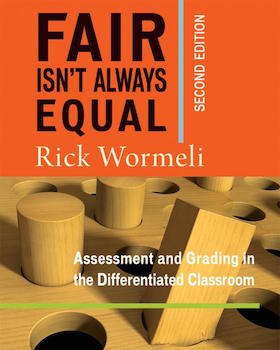Fair Isn’t Always Equal: 3 Grading Malpractices
Many conventional grading practices undermine students’ learning and our system of schooling. If you’re like me, you’ll recognize some of these grading don’ts from your current practices or from those you used earlier in your career.
This is okay: It’s hard to know everything in our field, particularly when we are new to teaching. Once we realize our mistakes, however, we must work to fix them.
We all know that if we expect to maximize student learning, we must provide helpful feedback, document progress, and inform our instructional decisions with relevant student performance data.
Grades are a significant part of that data, and we must do everything we can to make sure the grades reported for evidence are accurate renderings of mastery.
This requires us to critically examine some commonly accepted but often inappropriate grading practices and make necessary changes with genuine urgency. The students sitting in front of us today have a right to helpful assessments and accurate grading.
Here are just three examples of grading-related practices that warrant our close scrutiny.
1. Withholding assistance when students need it.
Imagine the situation in which a few students are struggling to make sense of text and the teacher provides a matrix or similar graphic organizer to help them structure their thinking.
Using the prompts from the organizer, these once-struggling students are now able to identify and organize salient information; they learn well. When it comes time to take the test, they are competitive with the best thinkers in the class.
Is this fair? Yes.
Do the grades for all students in this class represent accurate renderings of what they know and are able to do? Yes. The limitations to learning have been removed. Differentiation and scaffolding are in play.

If we want grades to be accurate indicators of mastery, then we have to remove any barrier to students gaining knowledge of the material, as well as any barrier to their successful demonstrations of mastery. To not do either of these tasks makes any subsequent grades reported false; they are based on misinformation, and the grade is no longer valid or useful.
Barriers in instruction and assessment include using inappropriate testing formats, requiring all students to learn at the same pace as their classmates, using the same tools with all students when different tools are needed by some, choosing inflexible teaching methods, and narrowing the focus of curricula, among others.
By the way, is it appropriate to offer the same graphic organizers to all students if we’re going to offer them to a few? Yes. Remember, the most professional thing we do sometimes is to get out of our students’ way. Some students won’t need graphic organizers, but some will. Using them doesn’t make it easier to learn; it actually pushes students further than they would be pushed without them.
2. Assessing students in ways that do not accurately indicate their mastery.
Let’s stop here and assess everyone who is reading this article.
Please express what you know about differentiation, grading, and assessment through a six-minute interpretive dance. You have three days to prepare the dance. You must be accurate, you must incorporate three major concepts within each of those areas, and you must cite all your sources properly.
Some readers would find this task intriguing, even motivating. Many others would be appalled. They’d ask for extensions, special resources/tools, coaching, or alternative formats, or they might even pursue unethical means to pass the assessment. Many would lose hope.
Welcome to the world of students who learn differently. A regular, no-nonsense, traditional test can stir the same reactions in many of our non-traditional kids.
Consider the following word problem:
Each new military jet costs 7.8 million dollars. The government wants to purchase eleven of them but has only 83 million dollars to spend. Will they be able to purchase all eleven jets?
Which operation(s) should students use to solve this word problem? Multiplication and subtraction. How do we know this?
Seriously, how do we know this?
Most of us probably have a picture in our minds: an image of a plane with “7.8 million dollars” written over it. Then maybe we realize that all we have to do to solve the first part of this problem (yes, we realize there will be more than one part) is to add 7.8 million dollars to 7.8 million dollars to 7.8 million dollars to 7.8 million dollars and so on, eleven times.
Just as soon as we imagine this, however, we realize that this repeated addition is the same as multiplication, which is much faster. Then we start searching for which numbers to multiply, and based on our understanding of the picture in our heads and what we think the problem is asking, we choose to multiply 7.8 million and eleven.
Whatever this total is will be compared with the 83 million dollars, which is done by subtracting. We’ll note the difference, revealing whether we are over or under the stated budget, and then answer the question.
Clearly, this example shows that word problems often require reading comprehension in addition to knowledge of math. We can’t begin to solve this problem until we have a clear picture of the situation’s logic and what’s being asked of us, and that can be captured only if we read the problem correctly.
Now imagine a student who is brilliant in math but new to this country. Her English proficiency is very low. She cannot form a picture in her mind from the word problem itself, but if the problem were explained to her orally in language she understands, she could accurately multiply the larger numbers and compare them with the $83 million budget, arriving at an accurate answer.
The word problem test format previously discussed does not allow her to reveal her true level of proficiency with the mathematical concept.
Or how about the student who speaks conversational English, but is not familiar with academic English? He doesn’t understand that compare and contrast in the assessment prompt means similarities and differences nor that compare means both similarities and differences, not just similarities. As a result, he doesn’t respond fully to the assessment prompt, and he scores poorly.
There are many students who don’t speak the “language” of the assessments we give them:
- The highly interpersonal child is asked to work alone for hours at a time.
- The impoverished child is asked to determine the appropriateness of a budget for an extended European vacation.
- The writing/reading learning disabled child is asked to make sense of advanced text without any of his or her normal tools or strategies for success (a focusing T square, a graphic organizer, listening to the text on CD or download, being able to read the words aloud, using assistive technology to make a response, or being given an extended time period).
With all three students, their performance will be distorted by the assessment format or approach. The grades reported are useless to the teacher and to the student.

As students, we would say the test is unfair. We’d claim that we knew the novel’s theme, just couldn’t get it across to the teacher via the assigned format. If we are assessing students’ essay writing, then we use essays as assessments. If we are assessing something else, then we consider using an alternative format in lieu of the essay or, at the very least, in addition to it.
Let’s be clear: Essays are excellent assessment tools and are worth assigning for their own sake because they teach students rhetoric and reasoning that transfer to many other subjects and life. When it comes time to consider the accuracy of a grade, however, we must be sure that the assessment format reveals the truth about a student’s proficiency. If not, it should be scrapped for something more accurate.
With every assessment, we must consider what we are trying to test and find the best way of revealing what students know.
3. Allowing extra credit and bonus points to change the grade report.
“Mr. Terwilliger,” David asks. “I didn’t do so well on that written political cartoon analysis. I need to do something to raise my grade. Could I do a poster or something on cartooning for extra credit?”
“Sorry, David,” Mr. Terwilliger replies. “I’m not a fan of allowing students to do extra credit to boost their grades. You can’t substitute posters and other things for assignments, because I give assignments with a specific purpose in mind. In this case, how does doing a poster on cartooning teach you to analyze political cartoons in writing or prove that you can?”
David looks down, his face crumbling in early panic. “It doesn’t,” he admits.
“I tell you what,” his teacher continues. “You can go back and redo the written analysis until you meet the high standard of excellence set for it. What do you say?”
David looks up, not appeased, but not completely lost. “I don’t think I can do any better. I worked on that for a long time, and all I got was a D+. I don’t know how to do it differently.”
“Well, look at it as your first attempt. You have more feedback now. Let’s take a look at what still needs improvement. I’ll help you decide the right direction to go as you rewrite it. You’ll get it.”
David thinks for a moment before speaking. “Okay, but I don’t know how I’m going to do this and keep up with my regular work. I have a baseball tournament every night this week.”
Mr. Terwilliger nods. “It’s not insurmountable. Let’s see what we can work out.”
Many teachers offer extra credit as a way for students to improve a low grade. They think it gives students hope, and if the student is willing to take the initiative to do something a little extra, he should be rewarded by the addition of more points or a raised grade.
Remember, though, that grades should not be used as rewards. Nor should they be used as affirmation, compensation, or validation. Grades should represent an honest report of evidence at this moment in time, nothing more. If we make them something more than that, we undermine the student’s maturation and any useful purpose for grading.
Some teachers also offer extra credit as incentive to students to stretch themselves, pushing beyond the regular unit of study. They might announce to a class, “Anyone who wants to earn an extra 25 points can do so by analyzing the current political climate for environmental protection programs and compare it with the political climate for such programs in the mid-1990s. What’s changed, how are we affected today, and what is the likely climate for environmental protection programs twenty years from now?”
Such opportunities for advancement seem relatively safe and routine, but we need to be very careful with extra credit offers. We should avoid anything that will alter a grade’s accuracy. For example, if a student demonstrates a C level of mastery, she shouldn’t be given an opportunity to artificially inflate that grade with other work that doesn’t hold her accountable for the same benchmarks or learning outcomes as the original assignment.
Although we might consider alternative ways to demonstrate mastery when we are designing our units, we want to give serious consideration to the final choices, ensuring that each one has a clear purpose. If an alternative assignment accounts for everything we are seeking, then we can use it.
Other grading practices that harm students
These are just three of the 10 malpractices I explore in Fair Isn’t Always Equal (and the discussion of these three has been shortened for space). Rather than leave you wondering, I’ll list the other seven:
► Incorporating nonacademic factors, such as behavior, attendance, and effort, into report card grades.
► Prohibiting re-dos and retakes for (yes) 100 percent full credit.
► Grading practice work (including homework).
► Using a group grade to assess any one student on the standard.
► Grading on a curve.
► In mastery-based classrooms, using norm-referenced terms to describe criterion-referenced attributes (comparing students).
► Recording zeros on the 100-point scale for work not done.
If any of these common grading missteps triggers a flashing red light in your teacher brain, I hope you’ll take the time to explore their perils more fully.
Adapted from Chapter 15, “10 Grading Practices to Avoid,” Fair Isn’t Always Equal, 2nd Edition (Stenhouse, 2018) by Rick Wormeli. Read a review here at MiddleWeb.



































Brilliant analysis and examples. Thanks, Rick!
Gosh, Debbie, thanks! This means a lot coming from such brilliant star in the education universe herself! ‘Sure hope it leads to informed, thoughtful conversations instead of divisiveness and perpetuating old myths that never served anyone. And what’s really cool, is that once teachers are into the deep-dive of evidence-based, ethical grading, they see how a lot of its mindset translates into instructional practices, teacher-student relationships, professionalism, and more. I’m so grateful for the touchstones in my education life like you who have taught me so much and put up with me for so long. :-) Thanks again!. — Rick
What do you do for students that don’t show up and do the work? If you don’t give a zero for no work, what do you do?
Hi Elizabeth — It’s okay to record a zero or whatever symbol you might use to indicate no evidence was presented (I – Incomplete, IP – In Progress, NE – No Evidence, or NTY -Not There Yet, as examples), but the question becomes whether or not that zero is recoverable in full. That’s where I think educators cross a line. An F or a 0 isn’t really a failure so much as it is lack of evidence presented for whatever reason, moral or immoral, responsible or irresponsible. That’s the thing with grades — They should be purely information, just communication of evidence presented as of this one arbitrarily imposed calendar date, not judgments that invoke ego or shut students down. So, the suggestion, then, is to use policy and practice that engenders hope, not judgment and the end to learning. In most schools that implement grades as accurate, undistorted communication, they may record a zero or F, or more preferably one of the others listed above, but they are recoverable, changeable, when the student finally submits evidence of proficiency.
Thank you for the reply! I am an elementary and middle grades art teacher that focuses on mastery. I may assign 6 projects through a grading period, and have a few students that complete all well, some that complete all poorly, some that only complete 2 very well. I meet each student where they are and work to have them master a skill before moving on.
I get a little stuck when students don’t show or put forth any effort. I do not expect all of my students to enjoy or excel at art. I do expect them to show up and put forth effort. I grade with rubrics so they are less subjective, and I ask my students to complete self assessments on their skills and effort. There are still some that feel they deserve a good grade just for showing up. Or the students that don’t show up at all. That’s where I get caught up in the “I shouldn’t give 0’s.” If a student does not do any work towards a goal, they have chosen to be assigned a 0.
If you are grading students on “what they are capable of doing,” we should give them all A’s? Isn’t that really what we believe? Because every failure of students ultimately is your failure as a teacher for not providing the proper materials or coaching. In a perfect world with no time limits and no expectations from outside the classroom, this would work great.
My other question is: do you want to go to a doctor, attorney, or other professional who went through a program where they frequently don’t meet objectives, but get to revise over and over with supports from bosses and co-workers?
Hi Hans — Thanks for posting. I would love it if everyone had A’s recorded in the gradebook. It would mean that teaching and learning happened really well for everyone. It won’t happen in every standard we teach, of course, as reality gets in the way — some students need longer time periods than allotted to the learning, some need more support we are not resourced to provide, some teachers are better at solving problems than others, some are going through traumatic family issues, and so on. The goal, though, is that in the microcosm of the class we teach, we provide every opportunity to learn, not hide behind a uniform timeline or method of learning, then label the student for life for not learning within that uniformity.
Yes, in a perfect world, everyone would get A’s because we were wise and versatile enough to teach each student effectively. As you say, though, we have time limits and expectations from outside the classroom — so to what degree will we allow those time limits and outside factors to influence the sound pedagogy that happens within the classroom? I have no problem changing the master schedule, for example, if it would lead to greater student learning and maturation. I am also fine with grading ethically in my classroom, then translating it to the school district’s language, if they are not grading ethically, in order to keep my job. These are scary things, and not all teachers are comfortable doing them, I know, but it’s the stuff that shifts culture down the road and leads to positive student futures.
As for your second question, think about how those doctors, attorneys, and professionals became so competent as to be certified by those licensure exams and later to be highly qualified practitioners: They did those tasks, studied and re-studied, tested and re-tested over and over again. That’s how any person in any field becomes competent. Pilots do hundreds of landings before real passengers climb aboard their planes. Teachers teach hundreds of lessons before becoming fully professional, surgeons do dozens of practice surgeries before operating on live human tissue, and they have mentors standing next to them in the first five or six they perform on those live patients. Re-iteration with critique/feedback from expert colleagues is exactly how anyone becomes competent.
To claim that one-and-done assessments in the classroom is preparing students for the professional world of work is misguided. Heck, yes, I want my doctor, attorney, or professional to have completed a thorough preparation that was re-iterative, revised as a result of critique, then improved upon the next time the task or content was practiced. I want a lot of that. Notice, though, it’s not because he was a bumbling incompetent, but because this is the actual way people become professional.
In the end, if the certification exam can be trusted to create a valid report of that individual’s competence, then full licensure should be granted. If he wasn’t meeting objectives earlier in his learning, but is now, then we’re good. Most certification exams don’t test everything that’s needed for professional effectiveness, of course, so there should be multiple assessments used to determine any of that. The thing we don’t want to do here is to confuse the re-iterative learning process goals and expectations with post-learning, fully certified, in-the-field goals and expectations.
While I enjoyed the points in this article and took some things away, I am confused. In a perfect world, our students would never fail, parents would be on board with everything being taught, and our classrooms would run like clockwork. What do you do with the kid that refuses to redo the assignment? The kid that writes, “I don’t know” on every test answer, and when you offer him extra assistance he refuses.
What about the kid that misses 2-3 days weekly and becomes angry when you offer him additional assistance? Are we supposed to continue to give students half credit for zero work? If I give a 10 point assignment, and the student refuses to complete it despite the three other copies I gave him/her-then I am to reward him with a 5/10? With that logic, I should be able to come to work, grade 0 papers, teach nothing, watch movies all day and still receive half my paycheck.
Hi Amanda — I’ve had many of these students in my classroom over the years. It can be very frustrated, ‘agreed. These are emotional responses, however, not instructional, at least not yet. There is something going on here that is not natural for the ways humans are wired — We are built to learn. Seriously, we are.
When a student presents apathy, laziness, disinterest, there is always, always something else going on we can’t see or we can see, but can’t control. We’ll need to address that factor (or those factors) and return him to his true self — one that wants to learn, to be held in high regard by others, to do complex things, to achieve. No student ever strives to be a loser, to make sure the world knows he’s an idiot, to make sure they are “dead weight” in small group projects. They’re coping instead, trying to survive the day, hoping no one will find out they’re a fake. Learned helplessness is a real thing, for example, but it’s changeable.
Regarding your second paragraph: Grades shouldn’t be rewards. That policy will corrupt the entire system of making them accurate. So, first decide — are grades supposed to be accurate? If yes, then let’s move away from teachers and students perceiving grades as rewards. They’re just reports of evidence presented as of one date. Grades are not rewards for working hard. When grading, we don’t care how hard a child worked or not — it’s what evidence of learning did he present as of this one day?
A child could work for three solid weeks and demonstrate very little learning — We’re not going to raise his grade because he was so industrious, if that work does not represent the evaluative criteria for proficiency. And if a child worked not at all because he already proficient in the thing we were testing, we will not lower the grade because he was disobedient and didn’t do our work. Both of these would be knowingly falsifying the grade, which is deeply unethical. We have much more effective ways to teach adherence to deadlines, personal self-discipline, time management, etc., and not one of them — nor any research in the field — says to use grades and grading to teach such things.
Investigate why that child refuses to complete the assignment plus the three other copies you gave him or her. To be honest, this is the definition of insanity — doing the same thing over and over again but expecting different results. Kind of like giving a student who doesn’t do homework or classwork a zero every time he doesn’t do it. I would suggest the teacher needs the learning curve here, at least at first, not the student.
In these situations, we need to realize that homework/classwork are never to be graded/judged, if they’re being used to provide feedback and monitor progress toward a larger goal. They need to be low stakes, high feedback, in nature. We report compliance or “assignment completion rate,” separately from what they know about parts of a plant, then we dive in and respond to whatever is keeping them from doing the work that leads to real learning.
Re: Your analogy to teachers doing nothing but receiving half their paycheck, think about that again. You’re perceiving grades as payment for work done, regardless of what is learned. This is the corruption of grades as communication. If you offered no evidence of successful teaching, you should be fired, not paid, but this is a completely different situation than what’s happening in the classroom.
This student isn’t presenting evidence of compliance, so use the symbol that means, “No evidence of compliance,” such as a zero on the “Meets Deadlines” criterion. That’s far more accurate. They’re not getting something for having done nothing. I wrote about this extensively in the new edition of Fair Isn’t Always Equal, if you’re interested.
Don’t know if this helped, but I’m willing to explore it some more.
I’d like to follow this discussion
I appreciate your thoughts on this. I also agree about the “paycheck analogy”. I teach three levels of classes daily. One class would be my coteach class. This class receives the upmost modifications to assignments to meet their IEP needs and meet them at their level. I do not give homework-minus the 20 minutes of suggested nightly reading I ask the students to complete. Classwork, I often complete whole group, then small group, and then independently with a low point score (i.e. no higher than 15 but no lower than 5 points) as a way to gauge who needs more from me, peer tutoring, or something.
The problem I have is when a student earns a C; I struggle with how to explain to a parent that this is where their child’s learning currently is. A lot of students do not have an “A” understanding, and a ‘C’ understanding shows that they are average and learning at the perceived ‘normal’ rate. I accept late work. I offer students opportunities for reteach and retest, but a lot of parents ‘expect’ that I will just ‘give’ their child the grade because he/she did come up for tutoring or whatnot.
If the child is still achieving at an average level, how do you explain that to parents, who like so many of us, have been conditioned that grades are a reward for hard work. I understand your point in that they are not these things, and I am certainly not opposed to changing my mindset, but I don’t want my students to feel defeated.
I’ve been in the classroom for ten years, and I see children becoming more and more expectant that I will just ‘do’ what their parent commands, and that I bow to their every whim. This thought process of reworking and redoing can often get muddled when there’s a sense of entitlement. I’ll look into your book as I’m not opposed to your thoughts or feelings. Just like every ‘good’ teacher, I want to change the world, and I want to do the best I can, and I am still changing and improving each and every year. Most people think after ten years you’d be a professional, but I feel like each year is my first year because I’m changing something up and making something better. I appreciate your time. Thank-you.
Wow, Amanda, I want my children to have a teacher like you. Thank you for being so thoughtful and intentional about this. Your students will benefit — as will your colleagues.
Here are my initial responses to the comments so far:
First, grades aren’t earned, so we need to move away from that term because it perpetuates grades-as-rewards-bribery-coercion mindsets. They are only for accurate communication of performance against standards as of one calendar date, nothing more.
Second, if parents are expecting that a student will be given a higher grade just for participating in a tutorial, we need to re-educate parents, and fast. I agree completely with you that this is wrong, and that the entitlement expectation is on the rise. I usually have to have a, “One Dad to another” conversation, and ask what is the greater gift we give our children. In a trophy generation, we never want to give a false sense of competence, as this is humiliating when later, the child, his parents, and his future teachers think he can do something or knows something and he does not. This is not a positive legacy from a caring teacher.
The greater gift in the long run is always an accurate grade, even if it’s brutally honest. A really cool way to do this properly and students not to feel defeated is to report standards separately, not just academic ones separated from work habit ones, but even within the academic standards themselves. When we aggregate so much into one mash-up, aggregate, tiny little grading symbol, students quickly realize they are going to be only as good as the collective report of their weakest areas allows to be reported. So, if there were five standards on a test and they did well on two of them – that credit of their proficiency in those two would be totally distorted by the report of their digressions woven into the aggregate grade. There’s hope when things are separated out.
In addition, we want to look at the evaluative criteria themselves: If they don’t specify something that we are requiring nonetheless, then we need to change the grade. For example, think of the student who can’t read and comprehend content when reading on grade level text, but he can totally do it when it’s read aloud to him with proper vocal inflection. He should get full credit for the skill being assessed because the standard did not specify, “When reading silently on-grade level text, the student can…” and so on. I’ve had many students stay in the game and move on to much more complex performance and full achievement when there was hope for positive credit where evidence is clearly demonstrated like this.
Finally, to enter each veteran teaching year as a curious first year teacher is a wonderful, wonderful thing. I know it can be overwhelming — we all want to be more efficient — but that humility, curiosity, dedication, and openness of our first year are all extremely valuable and keep us from getting rigid and cynical. There are definitely some positives there. – Rick
Wow. The article is amazing (as I’ve come to expect from RW’s writing.) But, even more powerful, I think, are the responses to teachers you’ve shared. Rick, it is clear that you are truly passionate about makings schools and thus the lives of our students better. Bless your heart.
HI Rita – ‘Just saw this. I’m sorry for my delayed response. Thank you for your comments. They mean a lot. It takes time to be thoughtful and helpful (or so I hope), and it’s always nice to know that it’s appreciated. Your post here reminds me of others in my life I should thank for their extended thoughtfulness with me. — Rick
Hi,
As a teacher, how do you handle it when 10% of your classes (10-20 students) do not turn in work until the very last day of the semester. Let’s say one assignment a week and 18 weeks a semester. So there are approximately 180 assignments (plus the regular assignments) that need to be graded in 24 hours.
How am I supposed grade all this work in 24 hours? Moreso how is meaningful feedback supposed to be provided if there is no work turned in on a regular time table?
Lastly–students who turn in late work often cheat. The later the work is, the more likely the student copied or plagiarized the assignment–if I am watching them, I see them complete the work and can see the various steps of the process to turn in the completed work. If the student turns in everything at once, a lot of the checks and balances that actually show understanding and mastery no longer exist.
In short–if work is not turned in timely, the students tend not to be learning.
Thanks.
Mike